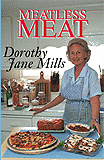 Why Meatless Meat?
Why Meatless Meat?
Are you a “vergetarian,” somebody constantly on the verge of becoming a vegetarian? Are you always falling off the veggie wagon because you wish veggies tasted like meat?
If you seem to see a large open space on your dinner plate where the meat used to be, what you need is recipes for meat substitutes that taste like meat. You need burgers, loaves, and stews that will satisfy your continued desire to eat meaty-tasting foods. You need my vegetarian cookbook, Meatless Meat.
Using its recipes, I’ve often fooled my dinner guests into thinking they were eating meat. And I’ve satisfied my own nostalgia for the meaty dishes I used to enjoy. Read what people are saying about Meatless Meat.
You can order an autographed copy online. The eBook version of Meatless Meat is now available from Thinker Media.
What’s Not in the Book and What Is in the Book
Meatless Meat has no dessert recipes, no salads, no fruit
dishes. It doesn’t even contain recipes for cooking vegetable side dishes. You can get recipes like that from any general cookbook. You don’t need a special vegetarian cookbook for them.
What Meatless Meat offers is a hundred amazing new recipes for main entrees that taste like the meat dishes you are used to eating. The recipes are easy, quick, and based primarily on ingredients you probably have in your kitchen right now, with one exception: textured vegetable protein.
Textured Vegetable Protein
A soy product, textured vegetable protein, or TVP, is carried by most health food stores and an increasing number of supermarkets. It’s a dry, fat-free product that you reconstitute with juices and sauces, and it’s very good for you. TVP is so versatile that it can be made to taste like the burgers, loaves, and stews you used to enjoy. You’ll be surprised how easy it is to prepare these recipes and how satisfying they are.
Four Requirements for a Good Meat Substitute
1. It must furnish a meaty texture. (Who wants to eat something flabby or mushy?)
2. It must be high in protein. (Vegetarians have to be sure they include enough protein in their diets.)
3. It must be quick and easy. (Who has time for “slow and difficult”?)
4. It should taste deliciously meaty. (Vegetarians are like everybody else. They want to eat something luscious, not something boring!)
Try a Recipe Now
Would you like to try one of my most popular creations right now? At the end of this article, you find my recipe for Hamilton Loaf, a vegetarian loaf named for Alexander Hamilton. Yes, it really tastes like ham loaf, according to the many delighted people who have eaten it in the mistaken notion that they were consuming the original meat-based dish.
Article Creates Interest
When the food editor of my local newspaper published an article about my forthcoming cookbook, Meatless Meat,
interested readers wrote me and sent e-mail messages asking when the book would be published. Others who hear about it want it right now because it’s what they need in order to eat much the way they used to eat and still become, or remain, the vegetarians they want to be.
An Interested Cooking School
During my visit to the New Orleans School of Cooking in February of 2000, Chef Michael DeVidts cooked a Creole Sauce that was out of this world. I resolved immediately to create a vegetarian version of his recipe, and when Michael learned of my intent, he invited me to return to the School and demonstrate my recipe when my cookbook is ready.
I included my recipe for Creole Sauce and seven other recipes in an article I wrote, “Cooking with Soy: Versatile TVP,” which appeared in the Autumn 2000 issue of Veggie Life, a popular vegetarian magazine. Our local Naples nutritionist wrote a favorable review of Meatless Meat in a column of the Naples Daily News, March 16, 1999, and she included a recipe for my “Saturday Night Spaghetti Sauce,” which is very meaty-tasting.
You can read a comprehensive review of Meatless Meat online at a site called Vegetarians in Paradise, http://www.vegparadise.com/
Here’s the Recipe for Hamilton Loaf
Why eat canned Spam when you can enjoy an entree with similar sharpness and sparkle that’s infinitely better for you? After I perfected this recipe I prepared Hamilton Loaf for a young woman I know who was recovering from surgery, or rather, for her husband, who is bewildered in the kitchen. He loved it and thought they were eating real ham.
This loaf is named after Alexander Hamilton, first American Secretary of the Treasury during the Revolutionary Era. Alex might have appreciated the revolutionary nature of this faux ham loaf. If he’d known about it, maybe he would have ordered it to be pictured it on the dollar bill. Textured soy protein is, after all, very much cheaper than meat, so promoting this loaf as a substitute for the original would have saved Americans of the 1700s a lot of money.
Ham loaf, popularized in the Depression as a cheap dish that
stretched scarce food money, was made of ground ham scraps and chopped vegetables, filled out with breadcrumbs or cracker crumbs, and held together with eggs. Brightly glazed and served with a tangy sauce, it was an eyefilling as well as tummy-satisfying dish. Hamilton Loaf does the same thing and tastes just as good.
To prepare Hamilton Loaf, bring to a boil 1 ½ C cranberry juice to which you have added 1 bay leaf, 1 t each thyme and marjoram, l/2 t ginger, 1 T bouillon powder, 1 t onion powder, and ½ t pepper. Pour this hot marinade over 1 C granulated textured vegetable protein and ½ C simulated bacon bits, and set aside for 15 minutes. Heat the oven to 350.
Combine ½ C finely chopped onion, ½ C chopped apple, and 2 T chopped celery. Saute for 5 minutes in 1 T oil.
Set aside. By the way, while you have an apple at hand, reserve about a quarter of it for slices to be used as garnish. Or, if you prefer a pineapple garnish, this is a good time to open a small tin of sliced pineapple, cut two or three slices of pineapple in half, and let them drain on paper towels.
Chop a couple of fresh tomatoes very fine, so that you end up with about 1 cupful. Or use a 14-ounce can of drained stewed tomatoes. Add the tomatoes to the sauteed veggies. Set aside.
In a large bowl put 1 C grated breadcrumbs or cracker crumbs. Now combine the sauteed vegetables with two eggs or the equivalent in Eggbeaters, 2 T honey, 1 T horseradish, and 1 small (5 ½ ounce) tin of tomato paste. Add this mix to the breadcrumbs and stir. After removing and discarding the bay leaf, add the marinated TVP as well. Mix well.
Pack the mixture into an oiled loaf-shaped baker about 4 ½ inches by 8 ½ inches and about 4 inches deep. Shape the loaf so that it’s higher in the middle. Cover with a glaze made of 1 T melted butter, 1 T ketchup or chili sauce, 1 T honey, and 1/4 C cranberry juice or applesauce, heated and then thickened slightly with 1 T cornstarch stirred into 1/4 C water. For extra tang you can add 2 T mango chutney and 1 t onion powder. Top the loaf with a few thin slices of apple or pineapple. If you’re inspired to extravagance, add a few dots of butter. Bake for about 45 minutes.
Meanwhile, decide whether you would like to serve a sauce. The classic accompaniment for ham loaf is one made of currant jelly, perked up with mustard or horseradish and fruit juice, vinegar, or wine. Since currant jelly is no longer as readily available as it was in the 1930s, to accompany Hamilton Loaf I often prepare a sauce made of ½ C jellied cranberry sauce, heated to melt. As it heats, I stir in 1 T horseradish and 1/4 t cloves. When it’s hot, I thicken the sauce slightly with 1 T cornstarch stirred into 1/4 C cranberry juice or water. Served in a bowl with a small dipper, this sauce makes a sparkling accompaniment for Hamilton Loaf.
Old-fashioned scalloped potatoes make the perfect complement to Hamilton Loaf. You prepare these by slicing potatoes thinly, spreading them in a shallow, oiled baker with some chopped onion, pouring on a little milk (or milk substitute), sprinkling some grated cheese on top, and baking the potatoes at the same temperature as the ham loaf until they have softened and are starting to turn brown at the edges. Steamed asparagus and acorn squash complete the nutritional requirements for the meal and look beautiful alongside the other dishes.
When your Hamilton Loaf is baked and beginning to turn a golden brown, let it sit on the stovetop, covered with foil, for fifteen minutes before you loosen it at the sides and slip it onto an oval serving dish. Doesn’t it look appetizing? And you’ll find that it tastes remarkably like ham loaf. This meal serves four people comfortably.
Instead of serving Hamilton Loaf at dinner, you may want to chill it in the baking pan and take it to your next picnic. Skip preparing the sauce. When the loaf is cold, loosen it at the sides and remove it onto a piece of foil wrap. You can slice it at the picnic. Prepare potato salad and a peas-and-carrots melange to enjoy with slices of Hamilton Loaf, and bring along jars of mustard, horseradish, and jalapeño jelly for those who love spicy condiments. You may want to call it Ham Loaf, for short. I’m sure Alex wouldn’t mind.
